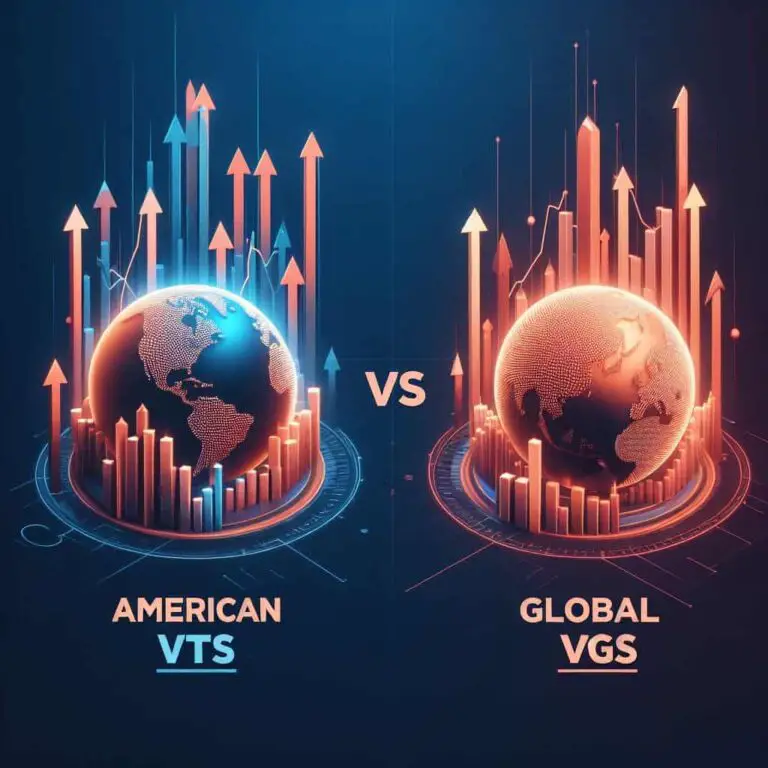IOO vs VGS: Which Global ETF Is Right For You?
Last Updated on 3 March 2024 by Ryan Oldnall
Over the past decade, the US stock market has displayed remarkable growth, even in the face of challenges like the Covid-19 pandemic. Despite a significant dip in early 2020, the 10-year total return currently stands at an impressive 11.91% [1].
Similarly, the Global MSCI World ex Australia Index has achieved a 10-year return of 11.08% as of August 31, 2023 [2]. In this article, we will compare the performance of two popular ETFs: IOO vs VGS.
VGS follows the MSCI World ex Australia Index and holds a substantial number of equities within a single ETF. In contrast, IOO tracks the S&P Global 100 Index, which has exhibited a 10-year return of 10.46% as of September 29, 2023 [3].
Our analysis provides an extensive insight into these ETFs, aiding you in deciding which one aligns better with your investment goals.
Many investors are curious about whether they should include IOO or VGS in their portfolios. So let’s get into it and compare IOO vs VGS.
VGS Vanguard Review
Vanguard MSCI Index International Shares ETF, commonly known as VGS, is a favored choice for investors seeking exposure to global equities.
VGS closely mirrors the performance of the MSCI World ex Australia Index, offering a diversified selection of equities from various countries and sectors.
Introduced in 2014, the VGS ETF is provided by Vanguard, a globally renowned investment management firm with a track record of serving more than 50 million investors across the world [4].
Vanguard has been active in the Australian market since 1996 and introduced one of its initial ETFs, VAS, in 2009, amassing an extensive portfolio with assets under management (AUM) exceeding A$10 trillion globally [4], [5].
Vanguard’s commitment to the Australian market is apparent, as demonstrated by its recent launch of a super fund in October 2022. I’ve subsequently performed a comprehensive Vanguard Super Review.
IOO Review
The IOO ETF, based in Australia, provides a strong investment option for those seeking broad exposure to global stocks.
This ETF is managed by iShares which is a collection of exchange-traded funds managed by BlackRock, a well-known global investment management firm.
The IOO ETF, introduced in Australia on October 10, 2007, boasts a 16-year history. It provides investors with a diverse portfolio of major global firms and manages $2.8 billion in IOO[6].
nInvestors who choose IOO can diversify across nations and industries, mitigating single-stock risks. This ETF offers exposure to top multinational corporations, making it appealing to those seeking sustained investment growth.

ETF Management Fees
ETF management fees represent the yearly costs linked to running and promoting an ETF, affecting your overall returns. It’s important to consider an ETFs overall fees, as lower fees ensure a larger portion of your earnings stays in your pocket.
ETFs are often preferred for their cost-effectiveness compared to other investment options. To understand the fee structure, it’s important to read an ETF’s Product Disclosure Statement (PDS).
In the case of IOO and VGS, they both feature somewhat reasonable management fees. For example, VGS has a 0.18% management fee. This means that with a $10,000 investment in VGS ETFs, you’d only pay $18 in fees.
On the other hand, IOO has a higher fee of 0.40%. This means that on a $10,000 investment in IOO, you’d incur $40 in fees annually. For the value each ETF provides some may find this fee to be very reasonable.
VGS Dividend History
The present dividend yield (distribution) for VGS stands at 2.14%, slightly below the index’s 2.33% dividend yield. This distribution is disbursed quarterly.
IOO Dividend History
The current dividend yield for IOO stands at 1.97% which is distributed semi-annually. The Divided yield is marginally beneath the index yield of 2.16%. For Australian investors, these yields might seem relatively modest, especially when compared to A200 vs VAS.
This is mainly because American companies typically don’t distribute dividends at the same rate as many Australian companies.
VGS vs IOO – 5 Year Annual Performance Comparison
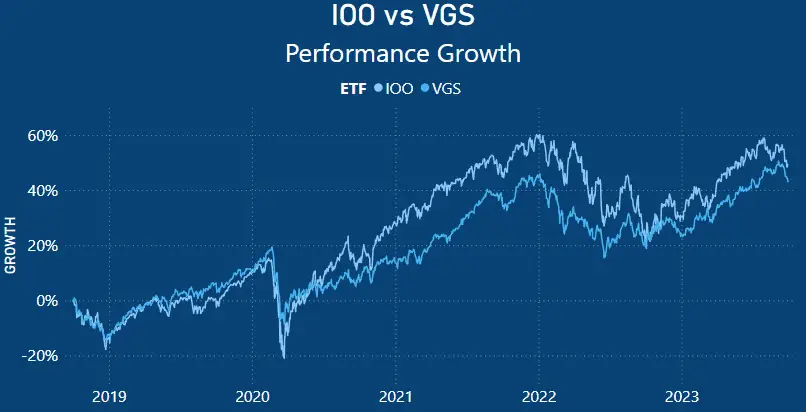
Examining the five-year performance trend starting in late 2018, it becomes evident that IOO has consistently out performed VGS.
Amid the COVID-19 pandemic in 2021, IOO returned outstanding returns by delivering 33.25%, outstripping VGS, which posted returns of 29.67%.
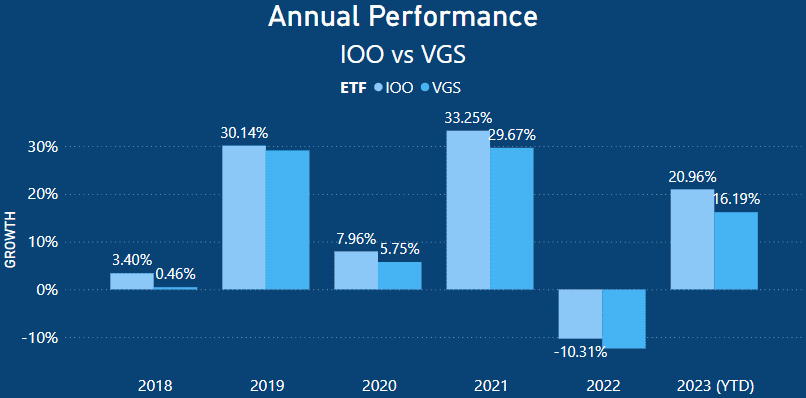
In 2022, market circumstances deteriorated due to rising inflation, heightened global recession risks, and the war in Ukraine. With both VGS and IOO being exposed to global companies they both endured substantial losses.
In 2023 year-to-date (YTD), IOO has shown robust growth with a 20.96% return, surpassing VGS’ 16.19%. This substantial performance difference of 4.77% is quite significant.
ETF Holdings
ETFs consist of a collection of individual stocks that form the core assets within the ETF. The ETF’s composition primarily hinges on the index it aims to replicate, its investment objectives, and occasionally, specific screening criteria such as ESG considerations.
In several instances, certain ETFs will allocate larger portions of their investments to particular stocks.
This holds true for both IOO and VGS ETFs. In VGS’ case despite comprising over 1455 equities, a notable portion of its investments is concentrated in a select few stocks.
Conversely, some ETFs adopt an equal-weighting strategy, where all the underlying stocks in the ETF are given equal importance.
This ensures that if one stock outperforms while others underperform, a process known as “rebalancing” takes place to maintain equal weight.
An illustration of such an Australian ETF is Vaneck’s MVW. I delve into this topic in greater depth in my review comparing MVW vs VAS – What Is The Best Australian ETF? The discoveries from this analysis might surprise you.
IOO Holdings
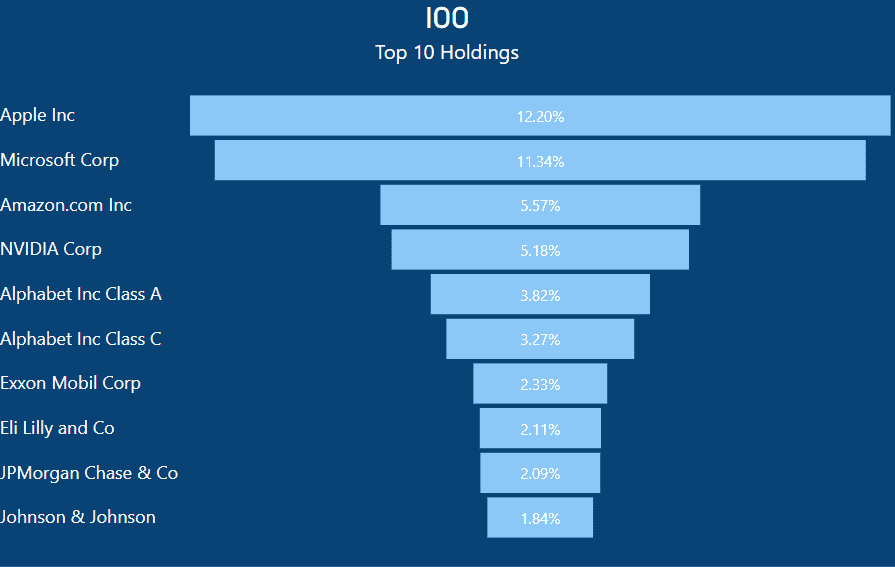
IOO features substantial investments in several American companies, with Apple taking the top position. Allocating 12.20% of its portfolio to Apple, meaning that for every $1000 invested in IOO, you would own $122.00 of Apple stock.
nConsidering the significant market capitalization of U.S. tech stocks, it’s unsurprising that they maintain a prominent position within the IOO ETF.
VGS Holdings

Similar to IOO, VGS also has a significant stake in Apple, albeit to a much lesser degree. If you were to invest $1,000 in VGS, you would possess approximately $50.42 worth of Apple shares.
It’s worth noting that Apple carries significant weight within this ETF, continually setting records as it was the first publicly traded company to achieve a staggering $3 trillion market capitalization.
Both VGS and IOO feature many of the same technology-related stocks, with the same top 5 shares. As previously mentioned, U.S. technology firms hold substantial market value, constituting a substantial portion of both these ETFs.
IVV vs VGS – Top 10 Holdings As Total Percentage of ETF
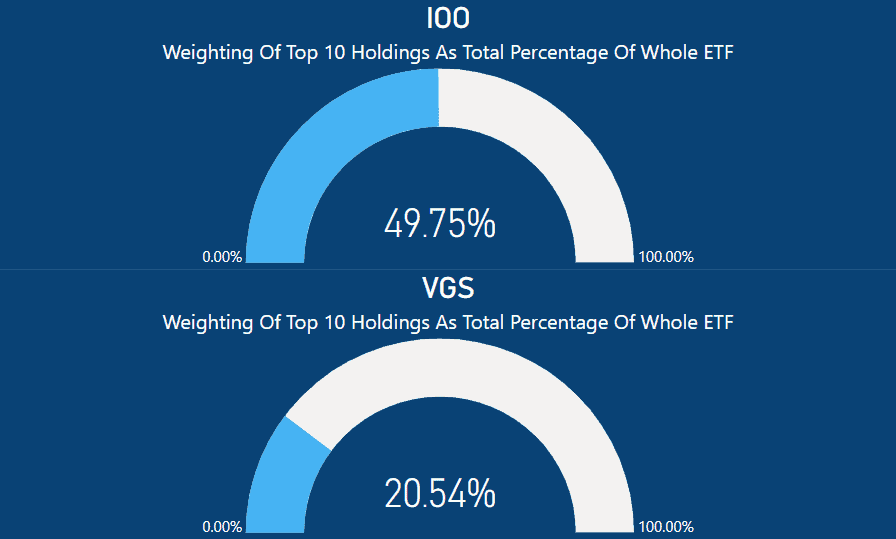
When you examine the top 10 holdings within each ETF, it becomes evident that their combined weight within the ETF constitutes a substantial amount.
Particularly in the case of IOO, the top 10 shares represent a significant 49.75% of the entire ETF.
Considering that IOO only invests in the top 100 global companies, this is somewhat surprising. This means that the remaining 90 companies account for the remaining 50.25% of the ETF.
In contrast, the VGS ETF has its top 10 holdings contributing to 20.54% of the ETF’s composition.
Although this is significantly less than IOO, it’s important to note that VGS invests in nearly 15 times the number of stocks compared to IOO, with a total of 1,455 stocks.
For instance, if you were to distribute the remaining 79.46% of the ETF among the other 1,455 equities, each would theoretically receive an allocation of approximately 0.05%. However, in practice, this doesn’t occur due to varying weightings for each stock.
IOO vs VGS – Market Cap Percentage
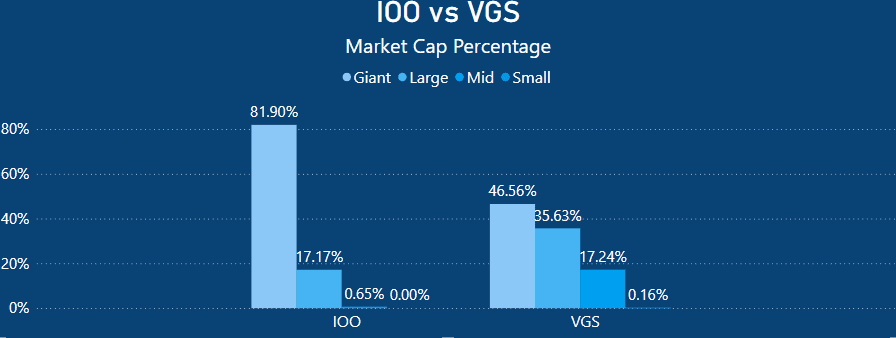
When looking at both IOO and VGS portfolios, it becomes evident that both allocate substantial proportions to large-cap and giant corporations.
Again, unsurprisingly, a significant majority of IOO is giant market cap companies as the ETF represents the top 100 global businesses.
VGS, on the other hand, has 46.56% in giant market cap businesses with 35.63% in large market cap companies.
Consequently, a substantial chunk of both ETFs is directed towards firmly established corporate giants recognized for their stability.
As a result, it’s highly improbable for either ETF to hold substantial starting positions in the next Tesla, Apple, or Google-like companies, given that these iconic firms initially emerged as modest enterprises and progressively expanded.
Within the framework of these ETFs, such companies would only represent a marginal portion of the overall investment until they attain a considerable market presence and draw in substantial investments.
IOO vs VGS – Weighting by Continent
When comparing IOO to VGS by continent, they are surprisingly very similar. IOO is composed of 75.79% North American companies, while VGS is slightly higher at 76.97%.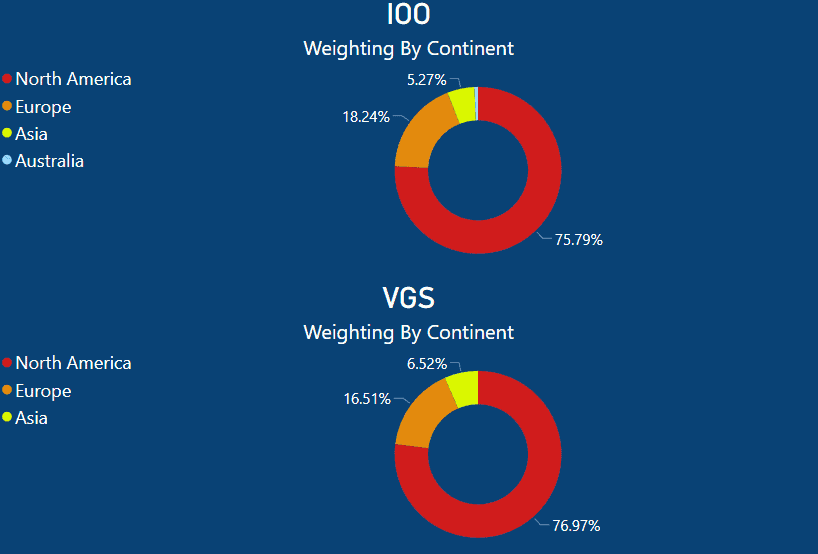 IOO has an 18.24% weighting in European companies, which is 1.73% higher than that of VGS, which stands at 16.51%.
IOO has an 18.24% weighting in European companies, which is 1.73% higher than that of VGS, which stands at 16.51%.
To round it out, IOO has 5.27% invested in Asian companies and 0.07% in Australian companies. On the other hand, VGS has 6.52% allocated to Asian companies.
Summary – Should You Invest in IOO or VGS, or Both?
IOO and VGS exhibit both similarities and differences in several ways. To begin with, IOO comprises only 100 equities within its ETF, representing the largest 100 companies globally.
In contrast, VGS currently encompasses 1455 shares in its ETF. This substantial difference is somewhat mitigated by the individual weighting assigned to each share.
Both IOO and VGS make substantial investments in companies such as Apple, Microsoft, Amazon, Nvidia, and Alphabet (Google). Furthermore, they share a similar level of exposure to the US market, with less than a 1% variation in continent exposure between the two ETFs.
IOO holds a 75.79% exposure to the North American stock market, while VGS stands at 76.97%. This means any head or tailwinds in these markets will be more of a driving force compared to fluctuations in the Asian or European markets.
So let’s answer the questions, IOO or VGS?
I am a huge fan of both ETFs. VGS offers remarkable diversification due to the extensive number of shares within its ETF. As I’ve discussed in my article, Buying Portfolio Diversification with Vanguard’s VGS ASX.
Conversely, IOO exposes you to the top 100 global companies, with a majority of them being from the US. While the ETF has demonstrated robust performance, it remains highly concentrated.
Nearly 50% of the entire ETF is invested in just 10 companies, a significantly higher concentration compared to VGS’s top 10 holdings of 20.54%. So, if your goal is to achieve comprehensive portfolio diversification, VGS would be a good shout
If you’re wanting to add a giant market cap type tilt to your portfolio and capitalise on the performance of the world’s largest companies, IOO might be your preferred option.
Should You Own both IOO and VGS together?
Like all financial decisions, this hinges on your individual objectives, goals, and financial circumstances.
Owning both IOO and VGS may result in some overlap within your overall portfolio. While this is not necessarily problematic, it’s worth noting that many investors also hold IVV.
As discussed in my comparison of IVV vs VGS, holding a combination of IVV, VGS, and IOO could potentially lead to an over-concentration in US tech stocks and the broader US market.
At best, you might consider holding two of these three options, rather than all three simultaneously.
- https://www.spglobal.com/spdji/en/indices/equity/sp-500/#overview
- https://www.msci.com/documents/10199/c27eeea3-ad05-4944-bef4-fbaef9ef34ec
- https://www.spglobal.com/spdji/en/indices/equity/sp-global-100/#overview
- https://www.vanguard.com.au/corporate/
- https://www.vanguard.com.au/personal/invest-with-us/etf?portId=8205
- https://www.blackrock.com/au/individual/products/273428/ishares-global-100-etf
This article does not serve as an endorsement or recommendation for products mentioned in the article. The information presented here is based on referenced sources and is accurate as of the publication date of October 1, 2023.








